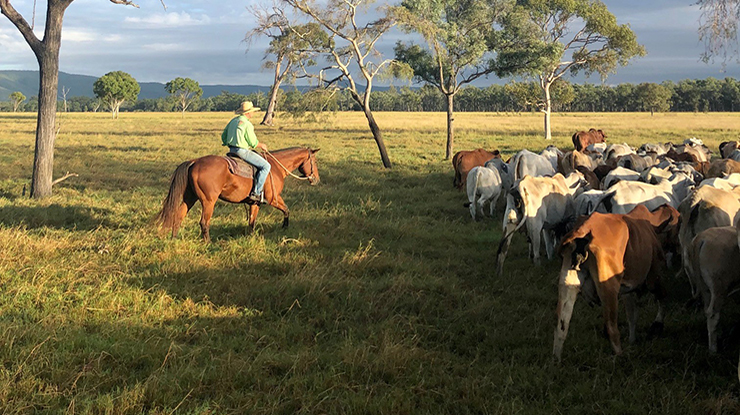
‘Mystery Park’, St Lawrence, Queensland
Strategic phosphorus (P) supplementation has allowed Queensland beef producers Rob and Ainsley McArthur to boost the productivity and profitability of their entire business.
Rob and Ainsley McArthur from ‘Mystery Park’, St Lawrence, Central Queensland operate a cattle breeding, backgrounding and agistment enterprise, running 5,000 tropically adapted composite cattle.
About 14 years ago, the couple recorded conception rates of below 60% in their breeder herd, as well as low growth rates across their commercial herd. Bulls are evaluated for breeding soundness each year and are joined with cows at 2.5% from 1 January for 63 days.
They decided to dig deeper to identify the cause and found an unexpected problem. Their region isn’t typically associated with deficient soil phosphorus concentration, but given their herd’s performance, the McArthurs decided not to rule out P deficiency.
“It wasn’t until we got our specific property lot numbers assessed with the Queensland Department of Agriculture and Fisheries for land and soil types and completed faecal sampling for an indication of diet quality (faecal NIRS [near infrared reflectance spectroscopy]) and P status through wet chemistry analysis, that we learned that some areas of our property were P deficient,” Rob said.
“Despite paddocks on creek flats showing adequate P concentrations, these paddocks weren’t enough to offset P deficiencies on the balance of our land types”.
“Learning about the different land types of our property enabled us to take a targeted approach with P supplementation.”
Supplementation strategy
To ensure P supplementation was cost‑effective, Rob and Ainsley set specific production goals. Initially, these were:
- target weights for yearling heifers and steers
- conception rate targets within the breeding herd.
The McArthurs begin supplementing P in the late dry season (September and October), just before late pregnancy.
“That’s generally still the dry season for us, and cattle most often have access to a urea-based, dry season supplement.
We begin adding P to this urea-based lick so that the cows can build their P reserves prior to first calves born in mid October,” Ainsley said.
When the season breaks and the animals’ nutritional needs such as energy and protein are already met by the grass, then P is the next biggest issue in the diet.
“We then ramp up the P supplementation in the growing season, making it ad lib (free choice) until the pasture’s growth slows and starts to hay off,” Rob said.
However, helping the cattle to meet their P requirements through consuming enough of the P supplementation was a challenging task.
“We persisted, and it really came down to trial and error,” Ainsley said.
The supplement needed to be palatable, easy to deliver during the wet season and cost‑effective.”
Eventually, the McArthurs settled on a winning combination which they’ve been using for more than five years now.
“We mix monodicalcium phosphate (MDCP) with a protein meal, which acts as an attractant to get the cattle to eat it,” Rob said.
“We are targeting lactating breeders to consume approx 10g P of MDCP per day and dry cattle about half of this per day.
“It’s important to remember that around 20% of the MDCP is phosphorous. To begin with we mix the protein meal and MDCP at a ratio of 1:1 and as cattle acquire a taste it moves back to a ratio of 1:2. This is then fed out in open troughs.”
Growing season results
As a result of implementing a P supplementation program, Rob and Ainsley have:
- improved body condition across their herd
- 18% increase in conception rates in their breeder herd (from 60% to 78%)
- increased heifer growth rates
- increased the percentage of heifers reaching target joining weights.
“The 18% lift in our pregnancy rate on the cows was achieved in a very tight joining window of 63 days which means our cows are having a calf every 12 months – this is a huge benefit to our business,” Ainsley said.
“We were able to put more pressure on the cows to go into calf earlier and as a result we have a more consistent line of weaners.
“The fact that we’ve got more kilograms on the herd means we’re producing more kilograms of beef per hectare – this has improved our gross margin and we’ve been able to be market ready, earlier.
“P supplementation has helped us maintain body condition score on the cows as well, which contributes to them being able to get back in calf earlier. Retaining cows at body condition score of three or more has a huge impact on their ability to reconceive.”
“As soon as we got the P intake correct, we saw the results within the growing season,” Rob said.
“P supplementation for us was a low hanging fruit in our business. It’s not a magic bullet but it’s a one percenter that if you add all those up together, it helps with production,” Ainsley said.
Measurement is key
According to Rob and Ainsley, measuring everything is key to seeing results.
“We know how much the protein meal and MDCP is per tonne, we know how many kilograms are delivered to each paddock and how many grams per head the cattle are eating,” Ainsley said.
The McArthurs test faecal samples to monitor phosphorus levels in the cattle’s diet as well as other key nutrients such as dietary crude protein, dry matter digestibility, faecal nitrogen and the non-grass proportion of their diet.
“Regular testing allows us to ensure our P supplementation strategy is meeting the requirements of the cattle year-to year,” Rob said.



